History of English I Krista Vogelberg Part 3

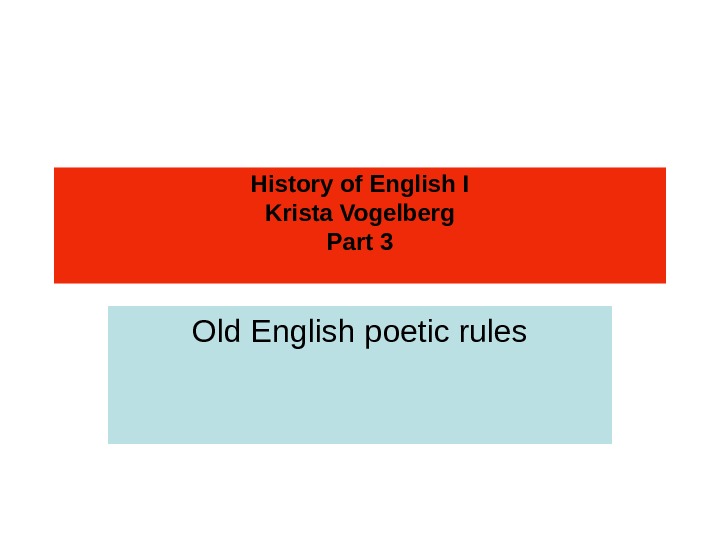
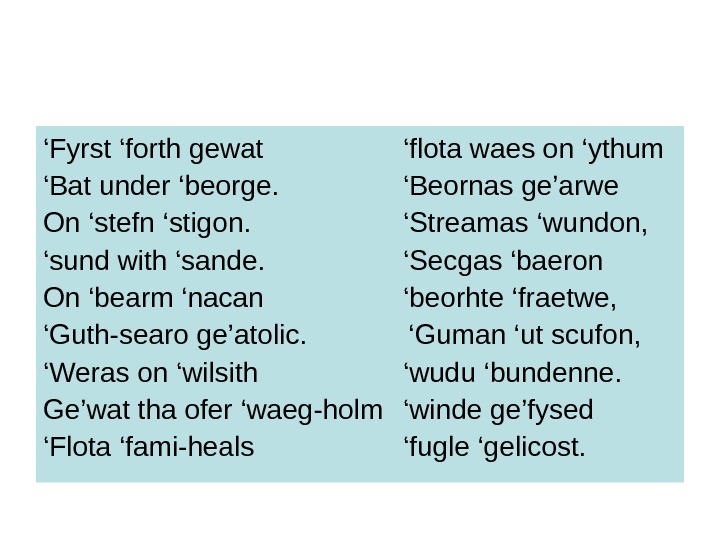
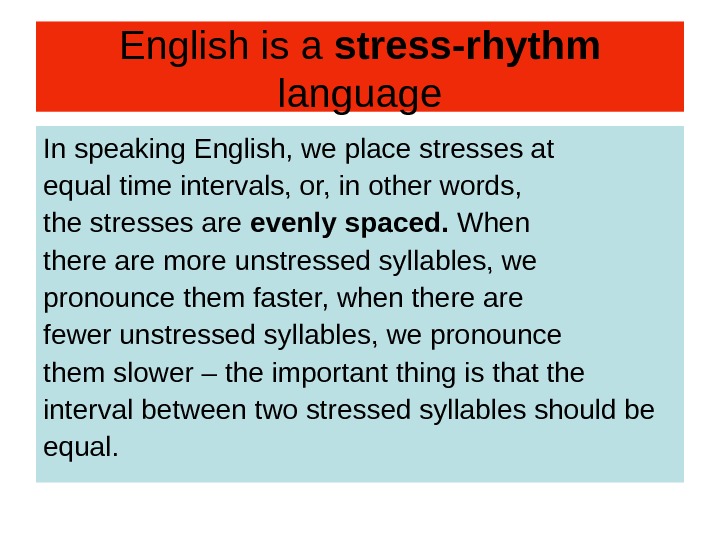



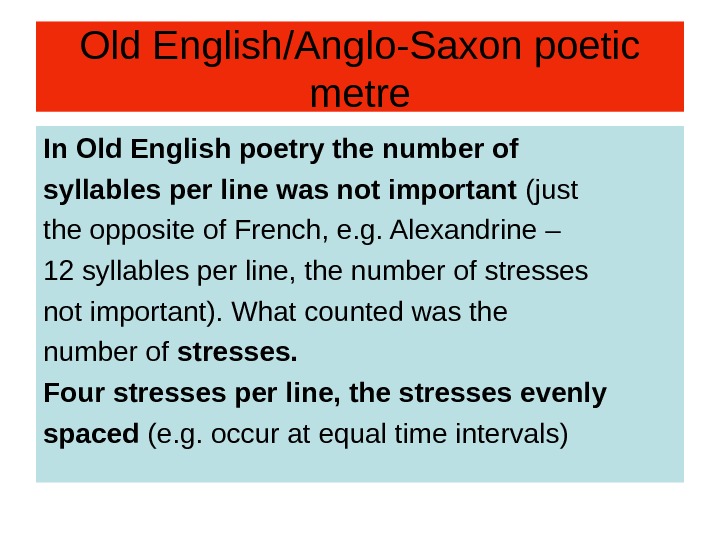
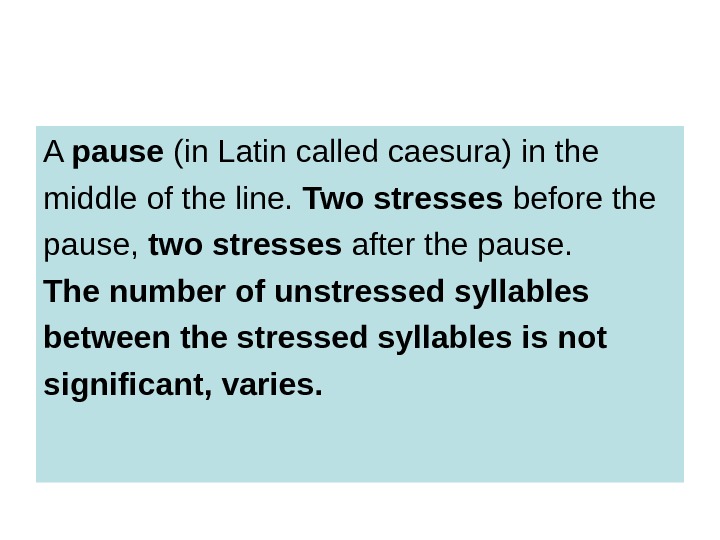
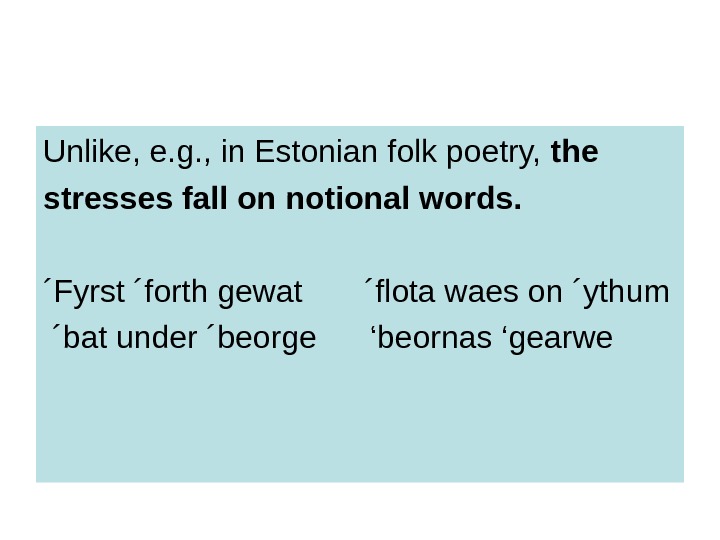

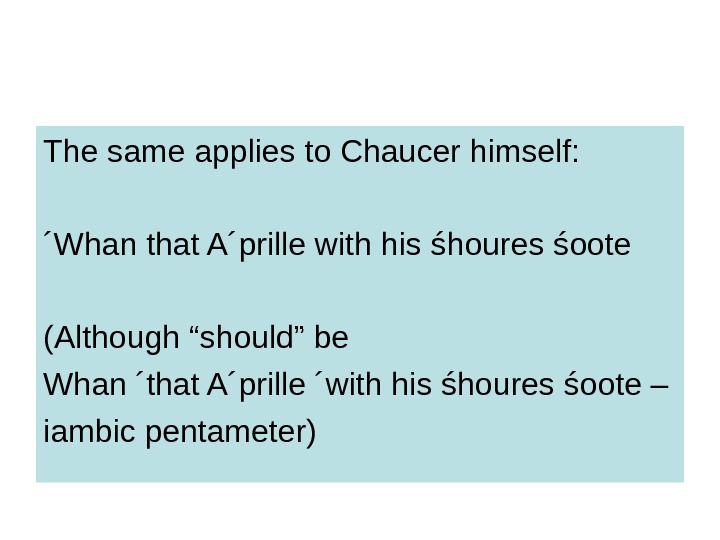
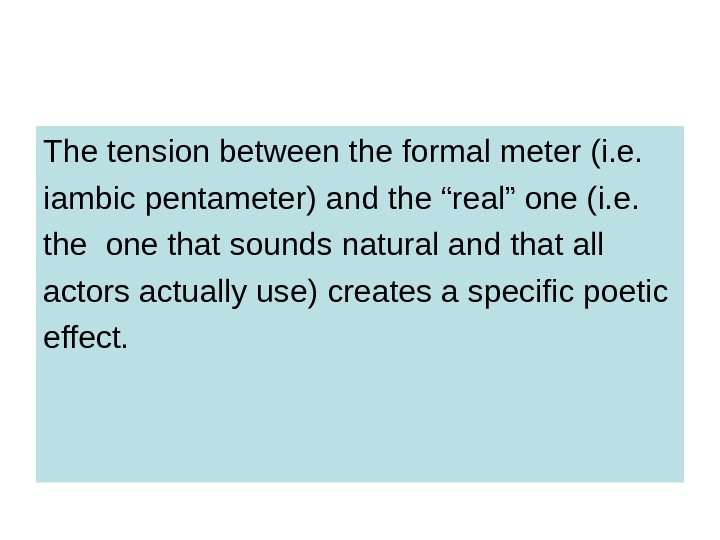

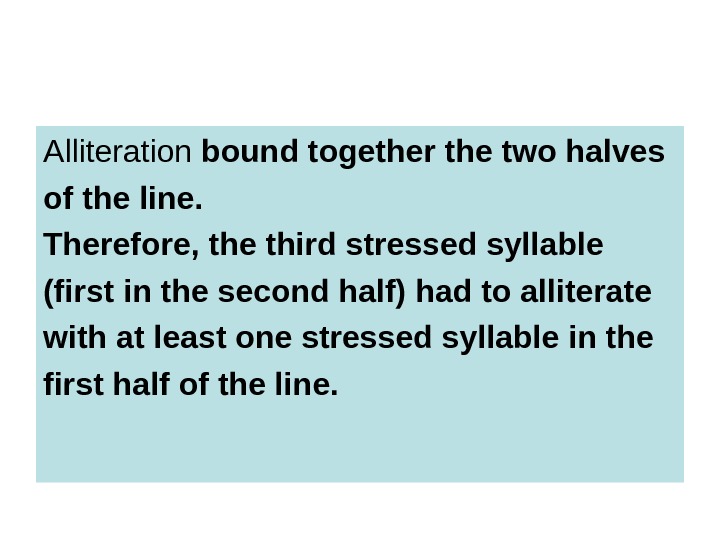
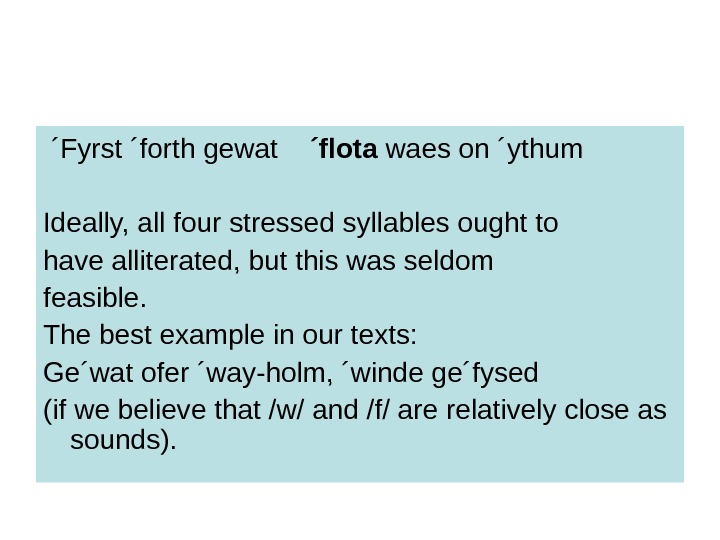

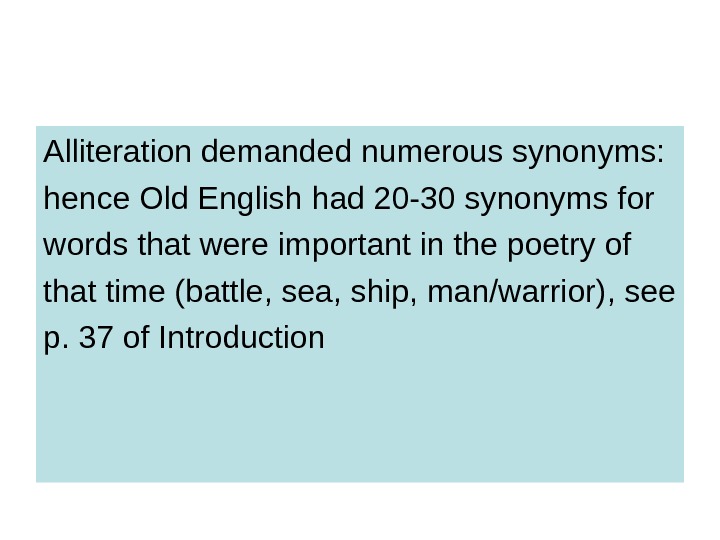
history_of_english_i_part_3_2009.ppt
- Размер: 52.5 Кб
- Количество слайдов: 17
Описание презентации History of English I Krista Vogelberg Part 3 по слайдам
 History of English I Krista Vogelberg Part 3 Old English poetic rules
History of English I Krista Vogelberg Part 3 Old English poetic rules
 ‘ Fyrst ‘forth gewat ‘flota waes on ‘ythum ‘ Bat under ‘beorge. ‘Beornas ge’arwe On ‘stefn ‘stigon. ‘Streamas ‘wundon, ‘ sund with ‘sande. ‘Secgas ‘baeron On ‘bearm ‘nacan ‘beorhte ‘fraetwe, ‘ Guth-searo ge’atolic. ‘Guman ‘ut scufon, ‘ Weras on ‘wilsith ‘wudu ‘bundenne. Ge’wat tha ofer ‘waeg-holm ‘winde ge’fysed ‘ Flota ‘fami-heals ‘fugle ‘gelicost.
‘ Fyrst ‘forth gewat ‘flota waes on ‘ythum ‘ Bat under ‘beorge. ‘Beornas ge’arwe On ‘stefn ‘stigon. ‘Streamas ‘wundon, ‘ sund with ‘sande. ‘Secgas ‘baeron On ‘bearm ‘nacan ‘beorhte ‘fraetwe, ‘ Guth-searo ge’atolic. ‘Guman ‘ut scufon, ‘ Weras on ‘wilsith ‘wudu ‘bundenne. Ge’wat tha ofer ‘waeg-holm ‘winde ge’fysed ‘ Flota ‘fami-heals ‘fugle ‘gelicost.
 English is a stress-rhythm language In speaking English, we place stresses at equal time intervals, or, in other words, the stresses are evenly spaced. When there are more unstressed syllables, we pronounce them faster, when there are fewer unstressed syllables, we pronounce them slower – the important thing is that the interval between two stressed syllables should be equal.
English is a stress-rhythm language In speaking English, we place stresses at equal time intervals, or, in other words, the stresses are evenly spaced. When there are more unstressed syllables, we pronounce them faster, when there are fewer unstressed syllables, we pronounce them slower – the important thing is that the interval between two stressed syllables should be equal.
 French, for instance, is a length-rhythm language: almost all syllables of equal length.
French, for instance, is a length-rhythm language: almost all syllables of equal length.
 Thus, English speech as occurring in real time can be described as follows (capital X – a stressed syllable, small x, an unstressed syllable): x. Xxxxx. Xx Xxxx X as against French Xxxxx. X
Thus, English speech as occurring in real time can be described as follows (capital X – a stressed syllable, small x, an unstressed syllable): x. Xxxxx. Xx Xxxx X as against French Xxxxx. X
 The stress-rhythm nature of the English language goes back to Old English times. Ilse Lehiste: indigenous poetry is closely linked to the phonetic nature of the language.
The stress-rhythm nature of the English language goes back to Old English times. Ilse Lehiste: indigenous poetry is closely linked to the phonetic nature of the language.
 Old English/Anglo-Saxon poetic metre In Old English poetry the number of syllables per line was not important (just the opposite of French, e. g. Alexandrine – 12 syllables per line, the number of stresses not important). What counted was the number of stresses. Four stresses per line, the stresses evenly spaced (e. g. occur at equal time intervals)
Old English/Anglo-Saxon poetic metre In Old English poetry the number of syllables per line was not important (just the opposite of French, e. g. Alexandrine – 12 syllables per line, the number of stresses not important). What counted was the number of stresses. Four stresses per line, the stresses evenly spaced (e. g. occur at equal time intervals)
 A pause (in Latin called caesura) in the middle of the line. Two stresses before the pause, two stresses after the pause. The number of unstressed syllables between the stressed syllables is not significant, varies.
A pause (in Latin called caesura) in the middle of the line. Two stresses before the pause, two stresses after the pause. The number of unstressed syllables between the stressed syllables is not significant, varies.
 Unlike, e. g. , in Estonian folk poetry, the stresses fall on notional words. ´Fyrst ´forth gewat ´flota waes on ´ythum ´bat under ´beorge ‘beornas ‘gearwe
Unlike, e. g. , in Estonian folk poetry, the stresses fall on notional words. ´Fyrst ´forth gewat ´flota waes on ´ythum ´bat under ´beorge ‘beornas ‘gearwe
 The old meter has actually survived! Althought Chaucer brought continental meters to Britain, the English language still shines through English poetry. Cf Shakespeare’s “Hamlet” To be or not to be, that is the question Officially iambic pentameter, i. e. , To ‘be or ‘not to ‘be that ‘is the ‘question actually only four stresses: To ´be or ńot to be, ´that is the ´question
The old meter has actually survived! Althought Chaucer brought continental meters to Britain, the English language still shines through English poetry. Cf Shakespeare’s “Hamlet” To be or not to be, that is the question Officially iambic pentameter, i. e. , To ‘be or ‘not to ‘be that ‘is the ‘question actually only four stresses: To ´be or ńot to be, ´that is the ´question
 The same applies to Chaucer himself: ´Whan that A´prille with his śhoures śoote (Although “should” be Whan ´that A´prille ´with his śhoures śoote – iambic pentameter)
The same applies to Chaucer himself: ´Whan that A´prille with his śhoures śoote (Although “should” be Whan ´that A´prille ´with his śhoures śoote – iambic pentameter)
 The tension between the formal meter (i. e. iambic pentameter) and the “real” one (i. e. the one that sounds natural and that all actors actually use) creates a specific poetic effect.
The tension between the formal meter (i. e. iambic pentameter) and the “real” one (i. e. the one that sounds natural and that all actors actually use) creates a specific poetic effect.
 Alliteration Old English poetry: initial rhymes (important for remembering! After all, the poetry was mainly oral, only selected poems written down by clerks at the command of noblemen/kings). Alliteration – consonants at the beginning of words are repeated. Alliteration applied to stressed syllables.
Alliteration Old English poetry: initial rhymes (important for remembering! After all, the poetry was mainly oral, only selected poems written down by clerks at the command of noblemen/kings). Alliteration – consonants at the beginning of words are repeated. Alliteration applied to stressed syllables.
 Alliteration bound together the two halves of the line. Therefore, the third stressed syllable (first in the second half) had to alliterate with at least one stressed syllable in the first half of the line.
Alliteration bound together the two halves of the line. Therefore, the third stressed syllable (first in the second half) had to alliterate with at least one stressed syllable in the first half of the line.
 ´Fyrst ´forth gewat ´flota waes on ´ythum Ideally, all four stressed syllables ought to have alliterated, but this was seldom feasible. The best example in our texts: Ge´wat ofer ´way-holm, ´winde ge´fysed (if we believe that /w/ and /f/ are relatively close as sounds).
´Fyrst ´forth gewat ´flota waes on ´ythum Ideally, all four stressed syllables ought to have alliterated, but this was seldom feasible. The best example in our texts: Ge´wat ofer ´way-holm, ´winde ge´fysed (if we believe that /w/ and /f/ are relatively close as sounds).
 Since every second half line was paraphrased (not repeated exactly, but the same scene often viewed from a different perspective) by the contents of the first half of the next line, remembering was ensured with the help of both sense and sound.
Since every second half line was paraphrased (not repeated exactly, but the same scene often viewed from a different perspective) by the contents of the first half of the next line, remembering was ensured with the help of both sense and sound.
 Alliteration demanded numerous synonyms: hence Old English had 20 -30 synonyms for words that were important in the poetry of that time (battle, sea, ship, man/warrior), see p. 37 of Introduction
Alliteration demanded numerous synonyms: hence Old English had 20 -30 synonyms for words that were important in the poetry of that time (battle, sea, ship, man/warrior), see p. 37 of Introduction

